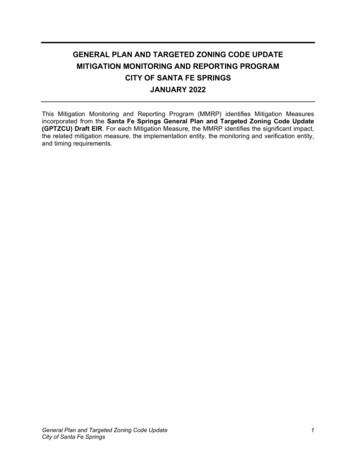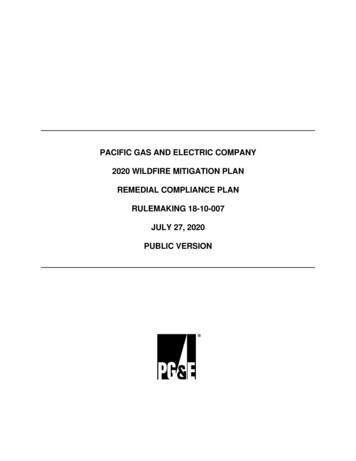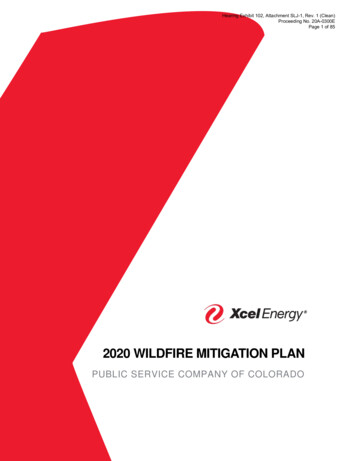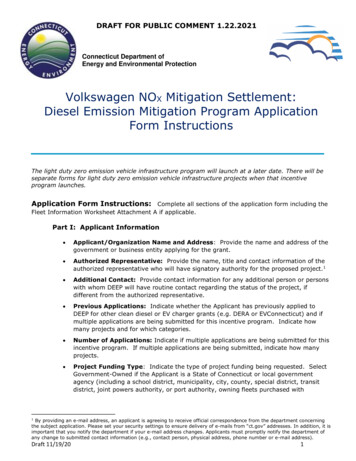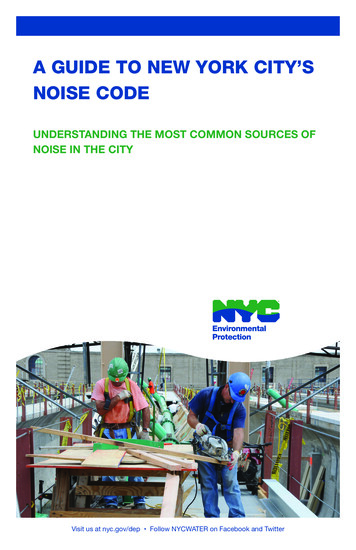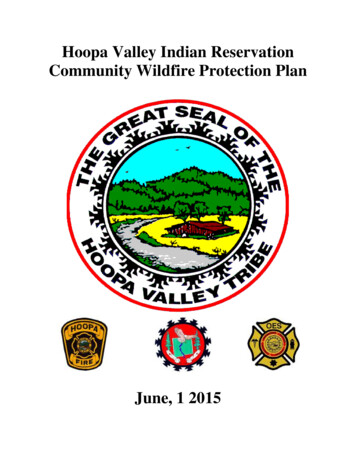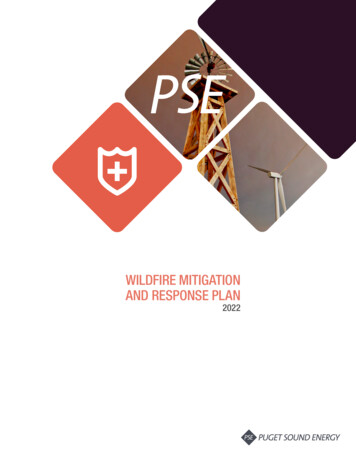
Transcription
WILDFIRE MITIGATIONAND RESPONSE PLAN2022
CONTENTS1.INTRODUCTION . . . . . . . . . . . . . . . . . . . . . . . . . . . . . . . . . . . . . . . . . . . . . . . . . . . . . . WORK . . . . . . . . . . . . . . . . . . . . . . . . . . . . . . . . . . . . . . . . . . . . . . . . . . . . . . . . 4PURPOSE . . . . . . . . . . . . . . . . . . . . . . . . . . . . . . . . . . . . . . . . . . . . . . . . . . . . . . . . . . . . 4SCOPE . . . . . . . . . . . . . . . . . . . . . . . . . . . . . . . . . . . . . . . . . . . . . . . . . . . . . . . . . . . . . . 4OBJECTIVES . . . . . . . . . . . . . . . . . . . . . . . . . . . . . . . . . . . . . . . . . . . . . . . . . . . . . . . . . 4ELEMENTS . . . . . . . . . . . . . . . . . . . . . . . . . . . . . . . . . . . . . . . . . . . . . . . . . . . . . . . . . . 4PERFORMANCE METRICS . . . . . . . . . . . . . . . . . . . . . . . . . . . . . . . . . . . . . . . . . . . . . . . 5EXECUTION AND CONTINUOUS IMPROVEMENT . . . . . . . . . . . . . . . . . . . . . . . . . . . . . . . 6CHRONOLOGY OF THE PSE WILDFIRE PROGRAM . . . . . . . . . . . . . . . . . . . . . . . . . . . . . . 6STAFFING . . . . . . . . . . . . . . . . . . . . . . . . . . . . . . . . . . . . . . . . . . . . . . . . . . . . . . . . . . . 6LESSONS LEARNED . . . . . . . . . . . . . . . . . . . . . . . . . . . . . . . . . . . . . . . . . . . . . . . . . . . . .PSE WILDFIRE RISK . . . . . . . . . . . . . . . . . . . . . . . . . . . . . . . . . . . . . . . . . . . . . . . . . . . 7WASHINGTON STATE FIRE ENVIRONMENT . . . . . . . . . . . . . . . . . . . . . . . . . . . . . . . . . . . 7HISTORICAL WILDFIRE ACTIVITY IN PSE’S SERVICE TERRITORY . . . . . . . . . . . . . . . . . . . 7PSE RISK ASSESSMENT AND MODELING . . . . . . . . . . . . . . . . . . . . . . . . . . . . . . . . . . . . 8WILDFIRE RISK ASSESSMENT . . . . . . . . . . . . . . . . . . . . . . . . . . . . . . . . . . . . . . . . . . . . 8WILDFIRE HAZARD POTENTIAL . . . . . . . . . . . . . . . . . . . . . . . . . . . . . . . . . . . . . . . . . . . 9WILDFIRE BURN PROBABILITY . . . . . . . . . . . . . . . . . . . . . . . . . . . . . . . . . . . . . . . . . . . 10WILDLAND URBAN INTERFACE . . . . . . . . . . . . . . . . . . . . . . . . . . . . . . . . . . . . . . . . . . 11WILDFIRE RISK MODELING . . . . . . . . . . . . . . . . . . . . . . . . . . . . . . . . . . . . . . . . . . . . . 12ANNUAL RISK RATING . . . . . . . . . . . . . . . . . . . . . . . . . . . . . . . . . . . . . . . . . . . . . . . . . 1.4.2.2.4.2.3.4.2.4.4.3.4.3.1.4.3.2.4.3.3.WILDFIRE MITIGATION AND RESPONSE PLAN ELEMENTS . . . . . . . . . . . . . . . . . . . . 14SITUATIONAL AWARENESS . . . . . . . . . . . . . . . . . . . . . . . . . . . . . . . . . . . . . . . . . . . . . 14STRATEGIC APPROACH TO SITUATIONAL AWARENESS . . . . . . . . . . . . . . . . . . . . . . . . 14DAILY WILDFIRE RISK DASHBOARD . . . . . . . . . . . . . . . . . . . . . . . . . . . . . . . . . . . . . . . 15FIRE WEATHER MONITORING AND RISK MITIGATION . . . . . . . . . . . . . . . . . . . . . . . . . . 16IGNITION AND FIRE RELATED EVENT TRACKING . . . . . . . . . . . . . . . . . . . . . . . . . . . . . 17ENHANCED INSPECTION TECHNOLOGY . . . . . . . . . . . . . . . . . . . . . . . . . . . . . . . . . . . . 17PRE-WILDFIRE SEASON INSPECTIONS . . . . . . . . . . . . . . . . . . . . . . . . . . . . . . . . . . . . 18FAULT REDUCTION . . . . . . . . . . . . . . . . . . . . . . . . . . . . . . . . . . . . . . . . . . . . . . . . . . . . 19ENHANCE VEGETATION MANAGEMENT . . . . . . . . . . . . . . . . . . . . . . . . . . . . . . . . . . . . 20PUBLIC SAFETY POWER SHUTOFF . . . . . . . . . . . . . . . . . . . . . . . . . . . . . . . . . . . . . . . 21DEPLOY COVERED OVERHEAD CONDUCTORS AND STRATEGIC UNDERGROUNDING . . 22ASSET MANAGEMENT . . . . . . . . . . . . . . . . . . . . . . . . . . . . . . . . . . . . . . . . . . . . . . . . 22FAULT PROTECTION . . . . . . . . . . . . . . . . . . . . . . . . . . . . . . . . . . . . . . . . . . . . . . . . . . . 23RECLOSE BLOCKING . . . . . . . . . . . . . . . . . . . . . . . . . . . . . . . . . . . . . . . . . . . . . . . . . . 24ARC SUPPRESSION FUSES . . . . . . . . . . . . . . . . . . . . . . . . . . . . . . . . . . . . . . . . . . . . . . 24OTHER SYSTEM RE-DESIGNED EQUIPMENT . . . . . . . . . . . . . . . . . . . . . . . . . . . . . . . . TIONAL PROCEDURES AND EMERGENCY RESPONSE . . . . . . . . . . . . . . . . . . . 25RESPONSE OPERATIONS AND COORDINATION . . . . . . . . . . . . . . . . . . . . . . . . . . . . . . 25ROLES AND RESPONSIBILITIES . . . . . . . . . . . . . . . . . . . . . . . . . . . . . . . . . . . . . . . . . . 25FIRE COMMAND INTERFACE . . . . . . . . . . . . . . . . . . . . . . . . . . . . . . . . . . . . . . . . . . . . 25SITUATIONAL AWARENESS . . . . . . . . . . . . . . . . . . . . . . . . . . . . . . . . . . . . . . . . . . . . . 26ACTIVATION THRESHOLDS . . . . . . . . . . . . . . . . . . . . . . . . . . . . . . . . . . . . . . . . . . . . . . 26EXTERNAL COORDINATION . . . . . . . . . . . . . . . . . . . . . . . . . . . . . . . . . . . . . . . . . . . . . 26RECOVERY . . . . . . . . . . . . . . . . . . . . . . . . . . . . . . . . . . . . . . . . . . . . . . . . . . . . . . . . . . 27RESOURCES AND CONTACTS . . . . . . . . . . . . . . . . . . . . . . . . . . . . . . . . . . . . . . . . . . . 27WA DNR DISPATCH CENTERS . . . . . . . . . . . . . . . . . . . . . . . . . . . . . . . . . . . . . . . . . . . . 276.COMMUNICATION AND OUTREACH . . . . . . . . . . . . . . . . . . . . . . . . . . . . . . . . . . . . . . 287.CONCLUSION . . . . . . . . . . . . . . . . . . . . . . . . . . . . . . . . . . . . . . . . . . . . . . . . . . . . . . . 29APPENDIX A-1:APPENDIX A-2:APPENDIX A-3:APPENDIX A-4:APPENDIX A-5:APPENDIX A-6:APPENDIX B:APPENDIX C:EXECUTION AND CONTINUOUS IMPROVEMENT . . . . . . . . . . . . . . . . . . . . . . . . . . . . . . 30SITUATIONAL AWARENESS . . . . . . . . . . . . . . . . . . . . . . . . . . . . . . . . . . . . . . . . . . . . . 31FAULT REDUCTION . . . . . . . . . . . . . . . . . . . . . . . . . . . . . . . . . . . . . . . . . . . . . . . . . . . . 32FAULT PROTECTION . . . . . . . . . . . . . . . . . . . . . . . . . . . . . . . . . . . . . . . . . . . . . . . . . . . 33OPERATIONAL PROCEDURES AND EMERGENCY RESPONSE . . . . . . . . . . . . . . . . . . . . 34COMMUNICATIONS AND OUTREACH . . . . . . . . . . . . . . . . . . . . . . . . . . . . . . . . . . . . . . 35INVESTMENTS BY BUSINESS PLAN WITH WILDFIRE RISK REDUCTION BENEFITS . . . . . 36CHRONOLOGY OF THE PSE WILDFIRE PROGRAM (2018-2022) . . . . . . . . . . . . . . . . . . 37
1. INTRODUCTIONSafety is Puget Sound Energy’s (PSE) top priority. PSE is an“all-hazards” company – our natural gas and electric systemsmust serve our customers through a range of weather andenvironmental conditions, such as high winds, flooding orearthquakes, as well as human-caused hazards such as vehicleaccidents or cyber threats. Emergency preparedness andresponse is at the core of our services, and we view meeting thegrowing challenge of wildfires as an extension of that responsibility.Included as Appendix A to this Plan is a summary of thePlan by strategic element, which includes recent actions,accomplishments, and next Plan milestones. Significantchanges to this Plan from the previous Plan are focused onmaturing risk assessment and data capture capabilities, aswell as providing increased detail regarding our overall strategyand increased details regarding how PSE will be implementingthis Plan. This year’s changes include:Over the past decade, wildfires have emerged as a significantpublic health and safety concern for much of the Western UnitedStates. As a result of climate change and chronic droughtconditions, the risk of wildfire now extends beyond historicallyactive areas into communities experiencing significant growth anddevelopment. While the severity of these conditions varies greatlyacross the West, and even within individual states, the growing riskwarrants appropriate assessment and mitigation by utilities andtheir regulators, as well as broader community and stakeholderengagement. A comprehensive, geographically specific, and datadriven approach that mitigates wildfire hazards while maintainingthe reliable delivery of energy is critical. Progress developing and implementing a public safetypower shutoff (PSPS) plan and related operations andcommunications processes for future use. Meetings scheduled this summer with potentiallyaffected customers and communities as well as withCounty Emergency Management staff in areas of higherwildfire risk. Additional information on PSE’s wildfire risk reductionmeasures that have been completed and those thatare planned. Increased staffing dedicated to PSE’s wildfiremitigation efforts. Updates and improvements to the risk model, operationalprocedures and situational awareness strategies.This Wildfire Mitigation and Response Plan (Plan) documentsour strategies, programs, procedures, and specific actions forresponding to wildland fires. It incorporates best practice modelsfrom risk management, operations, emergency management,communications, training and continuous improvement, with theultimate priority being the safety of our communities and customerswe serve and for the personnel that serve them. This Plan will alsocontinue to evolve as our collective understanding of wildfire riskevolves and new risk reduction strategies and technologies emerge.The following table represents a summary of the capitalinvestments made in 2020 and 2021 as well as the plannedinvestments through 2025 that will have reliability benefits aswell as reduce wildfire risks and improve response activities,as described in this Plan.Table 1: PSE’s capital investments 2020-2025 with reliability and wildfire risk reduction benefits2020MITIGATION TYPECOUNT2021 COUNT2022 COUNT2023 COUNT2024 COUNT2025 Fault Reduction4 3,700,00016 14,900,00013 11,900,00015 12,800,00027 34,000,000Covered Conductor2 12 5,900,0002 2,400,0008 10,400,0001 1,800,0001 2,800,000400,000 1,000,000UG UpgradeUG ConversionOH Upgrade1 2,000,0002 8,800,000--1 1,500,0003 13,600,0001 1 2,100,0001 3,500,0002 4,900,0001 2 1,700,0009 2,100,000200,000UG CapacityOH Capacity1 1,300,000Pole Replacement19 2,100,000Copper ReplacementFault Protection14 2,700,00012 2,400,000Wildfire11 2,400,00012 1,000,000 2,200,00016 6,400,0002 2,300,000111 2,000,000 600,0007 700,00019 3,300,000Recloser1 5 400,0007 600,00020 2,600,000Distribution Automation2 1,000,00012 3,600,000 1,400,00011 2,400,00018 6,400,00042 18,800,00052 11,500,00011 1,500,000Transmission Automation418 4,200,000Substation SCADA200,000 17 23,400,000500,000 2,200,00011 2,700,000COUNT2 2,500,00013 2,700,0004 3,000,00015 3,400,000 1,200,000600,000Appendix B provides a view of these investments by business plan over various timeframes and estimates the number of projects on wildfirecircuits for the outer years, as well as the proportion of the planned investments for those programs that will provide wildfire risk reduction benefits.3
2. FRAMEWORK2.1. PURPOSEThe Plan documents PSE’s strategies, operational procedures, and system investment approaches that enable PSE to identify,mitigate, and respond to evolving wildland fire risks that pose a risk to our services and communities. The Plan establishessafety as the first priority and describes methods in which PSE addresses situational awareness, notification, preventativemeasures, and response and recovery actions specific to wildfire risks.2.2. SCOPEPSE operates approximately 2,400 miles of transmission and 10,000 miles of overhead distribution circuits, including 340,000poles, and 430 substations in Washington State. PSE’s Plan monitors and considers all the service territory but focuses ondefined areas of wildfire zones and, through risk modeling, on areas where communities and assets are at the greatest riskof an occurrence. PSE’s reliability and resiliency investments throughout the territory help to improve wildfire resilience, but akeen focus on the circuits within higher wildfire risk areas is most valuable for this Plan.This Plan details the actions that PSE is currently performing to address wildfire risks in its service territory. It describes the stepsthat PSE is taking to improve the electrical system and the operational response to changing conditions to better manage thisevolving risk. Consistent with PSE’s continuous improvement model, Plan adjustments will be made periodically as new informationand experience is learned from our internal stakeholders, industry partners, regulatory bodies, customers, and communities. ThisPlan also includes PSE’s plans for communicating and working with customers and communities to ensure safety and reliability.2.3. OBJECTIVESThe objectives of this Plan are as follows: Uphold safety for the communities andcustomers we serve, and forour employees. Know the long-term and real-timewildfire risk in PSE’s service territorythrough development and maturity of theappropriate assessment tools Implement mitigation solutions thatbalance the risk of wildfire with safe andreliable energy delivery by prioritizinghigher risk assets and geographic areas. Leverage existing grid modernizationprograms to deliver benefits forwildfire resiliency. Incorporate communication with fireagencies into operational processesto ensure the safety of PSE employeesduring an active fire event. Inform customers of PSE’s wildfirepreparedness measures and ourcommunication protocols in the event ofa specific wildfire risk. Collaborate with customers andcommunities in the ongoing developmentof the Plan, particularly as it relates toensuring customer safety and reliability. Continuously improve this Plan throughlearning from others and deploy bestpractices as they become helpful toPSE’s territory and risks.42.4. ELEMENTSThe following elements focus PSE’s approach in delivering thePlan objectives: Situational Awareness: PSE’s wildfire risk modeling combinedwith weather forecast monitoring enables grid operators toproactively identify emerging risks associated with fire weather.Enhanced inspection technology pilots are under way to evaluatehow new tools might provide a more detailed assessment ofequipment condition and vegetation encroachment. Fault Reduction: Decrease the number of faults along PSE’ssystem by prioritizing reliability programs that strengthen PSE’sinfrastructure within higher wildfire risk areas in order to reducethe potential for wildfires. Fault Protection: Reduce the duration and extent of faults alongPSE’s system. Adopt common fault protection tactics includingaltering automatic reclosing and protective device settings andinstalling covered conductor. Operational Procedures and Emergency Response: Operationwithin wildfire zones and during wildland fire weather events may bedifferent than traditional operating procedures, increasing the needto predict conditions and respond proactively as well as coordinateemergency response differently and with many other entities. Communication and Outreach: : Effective external andinternal communication is essential for coordinated preventionand response to wildfires. PSE will host several communityengagement sessions in higher wildfire risk areas to informand develop unique community- and customer-centric actionsand wildfire mitigation tools, such as a PSPS plan. In addition,PSE works with land management groups ahead of fire seasonand fire response personnel during wildfire events. Customercommunication follows established protocols from storms andother emergencies.
2.5. PERFORMANCE METRICSPSE is currently developing performance metrics andtracker measures relative to the Plan’s progress and wildfirerisk reduction, as well as to report on outcomes of wildfirerelated projects and process improvements. Performancemetrics currently under consideration include:Situational Awareness: Real-time situational awarenessis enhanced through operator dashboards utilizing publicrisk and weather datasets. System Operators can usethese dashboards to trigger operational decisions suchas non-reclose operation of distribution circuits, stagingfirst-response personnel, and required visual inspectionduring restoration efforts. For the 2022 wildfire season,PSE will also be implementing enhanced incident trackingcapabilities to inform development of this potentialperformance measurement. Dashboard uptimeNumber of dashboard improvementsNumber of pre-season inspections performed on timeNumber of agency coordination events Miles of WUI (increasing over time)Fault Reduction and Protection: Core aspects ofPSE’s broader grid modernization efforts aim to enhanceasset maintenance and replacement as well as improvecircuit performance by increasing system protectionand decreasing system faults. This may include insulatorreplacement and bonding, covered conductors, targetedundergrounding, spacers, splices, and conductor spacing.Preventing outages through system hardening investmentsis directly tied to reducing wildfire risks. Number of reclosers installed in support of SupervisoryControl and Data Acquisition (SCADA) enablement SCADA upgrades to circuit breakers Distribution Automation schemes installedOverhead equipment failure trackingDistribution grid hardening projects completedNumber of fiberglass arms installedArc-suppression fuses installedFR3 t ransformers installedMiles of bare conductor upgradedMiles of conductor undergrounded Miles of covered conductor installed Number of PSPS deployed5Enhance Vegetation Management: PSE’s approachincludes enhanced vegetation management within higherwildfire risk areas, which includes expanding vegetationclearances, review of vegetation clearing frequency,increasing visual and drone inspections, and implementingan expanded off-right-of-way danger tree removal plan. Number of grow in outages Number of limb outages Number of fall-in outages from outside the ROW Number of hazard trees removed Number of trees trimmed Planned and completed mileage for vegetationmanagementOperational Procedures and Emergency Response:PSE’s operating procedures in higher wildfire risk areasand during wildland fire weather events may differ fromtraditional operating procedures, as there is an increasedneed to predict local environmental conditions andproactively coordinate emergency response differently andwith many other entities. Number of PSPS deployed Number of overhead equipment failures Number of system operations actions taken fromdashboard useCommunication and Outreach: Key communicationstrategies to communities and customers before andduring wildfire-related disruptions will use a variety oftraditional and digital media, depending upon the nature ofthe disruption, to provide updates and information. Thesecommunications strategies include: Number of community meetings per year Number of informational channels and media deployed Number of meetings with fire agencies Number of meetings with forest land agenciesContinuous Improvement and Program Effectiveness:PSE is also developing metrics to evaluate all the combinedperformance measurement categories to developappropriate wildfire risk mitigation processes discussedabove. These metrics include: Number of ignition eventsNumber of arcing eventsAcres burnedIndustry standard practices deployedNumber of root cause analyses performed
2.6. EXECUTION AND CONTINUOUS IMPROVEMENT2.6.1. CHRONOLOGY OF THE PSE WILDFIRE PROGRAMAppendix C is a Chronology of the development of the Wildfire Program at PSE. This details the steps PSE has taken since the2018 Camp Fire, which was the deadliest and most destructive wildfire in California’s history. It documents the development andmaturation of PSE’s Plan and supplements the additional actions that are discussed throughout this Plan.2.6.2. STAFFINGFor 2022, PSE has added two additional staff positionsdedicated specifically to the planning, administration,and continuous improvement of PSE’s wildfiremitigation efforts. This includes a Wildfire MitigationProgram Manager and Asset Management-WildfireEngineer. In 2022, PSE is also adding a Data Scientist.These positions will ensure year-round progress onimprovements in the different elements of this Plan.PSE’s Wildfire Mitigation Program Manager isresponsible for leading PSE’s ongoing developmentand implementation of our corporate wildfire riskreduction strategies and assembling and leading multidisciplinary teams to ensure mitigation implementationaligns with overall corporate objectives. Additionalresponsibilities of this role include: Establishing governance and charter forthe program. Managing wildfire program budgets. Establishing and maintaining documentationthat demonstrates the effectiveness of ourwildfire investments. Prioritization of resources needed to deliver theprogram’s objectives. Facilitating communication and outreach activitieswith stakeholders including customers andWashington Utilities and Transportation Commissionregulatory staff about the wildfire program and otherwildfire risks, mitigation, and other associated issues. Engaging in industry working groups andworkshops on related wildfire related topics.PSE’s Asset Management-Wildfire Engineer is responsible for: Supporting the development of holistic strategies and processesfor reducing wildfire risk and improving reliability and resiliency. Providing technical expertise and guidance to the WildfireMitigation Program Manager. Assessing equipment reliability and performance needs froman asset management perspective. Developing and implementing asset management strategiesfor long-term system hardening in higher wildfire risk areas. Engaging with the industry and vendors to align with bestpractices and evaluate the potential for integrating newtechnologies or approaches to reduce wildfire risk. Working with standards to improve equipment specificationand exploring new technologies. Defining and reviewing metrics by which PSE can quantify thevalue of decisions based on risk, performance, and cost.PSE’s Data Scientist position will support PSE’s wildfire mitigationefforts. This person is responsible for: Leveraging data, internal and external, to developdifferent operational models for a predictive approach towildfire mitigation. Collaborating with different external entities to ensure PSE ison the front lines of latest wildfire mitigation efforts. Developing visualization for real-time monitoring andevaluation of data models.In addition to these new positions, many internal departments at PSEhave been and will remain actively involved in wildfire risk mitigation.2.6.3. LESSONS LEARNEDPSE will incorporate lessons learned from previous wildfire seasons and interactions with regulators, customers, peer utilities, industrygroups, and others. Examples of lessons learned during the 2021 wildfire season that are being incorporated in 2022 include: Situational awareness and formalized processes are vitally important as quick action is needed due to short timeline/notice of Fire Weather Watches and Red Flag Warnings. Improvements made for 2022 include the addition of more granularwildfire hazard potential (WHP) data provided by the United States Forest Service (USFS) for the annual Wildfire Risk Model,formalization of fire weather monitoring by System Operators, and upgrades to the Daily Wildfire Dashboard. Proactive action in advance of wildfire season (equipment inspections, vegetation trimming and removal) provides a certaindegree of confidence heading into wildfire season and should be conducted every year. PSE will conduct pre-wildfire seasoninspections, vegetation management, and equipment maintenance again in 2022 and each year moving forward, targetinghigher wildfire risk areas based on our annual risk assessment. Continuous improvement methodology requires year-round attention to iterating and improving wildfire tactics and strategies.For 2022, PSE has added staff dedicated to the execution and improvement of this Plan. Formalized daily ignition/fire event-logging practices are needed for identification of trends that may need further analysis andcorrection. PSE is developing improved event-logging procedures that will be implemented prior to the 2022 wildfire season. Continued participation in industry groups and collaborative workshops with industry associations is beneficial as we continueto advance PSE’s wildfire mitigation strategies.6
3. PSE WILDFIRE RISK3.1. WASHINGTON STATE FIRE ENVIRONMENTWashington is not immune to the effects of climate change, which are projected to increase in nature over the next severaldecades. Summers are projected to be drier and warmer, and extreme weather events may become more likely. Changingweather patterns can shift tree pests and disease as well, causing additional fire load in forests and in the adjacent wildlandurban interface (WUI).Increased development in areas exposed to wildfire risk means that the potential consequence of wildfires on humanpopulations is increasing. Human settlement and forest management practices have led to increased fire suppression activitiesallowing for additional accumulation of fuel.As PSE continues to implement and mature this Plan, an increasingly granular understanding of evolving wildfire risk within ourservice territory will help PSE to take action in an efficient and effective manner. Western Washington has not historically been proneto frequent wildfires, and as changing conditions shift the risk landscape across PSE’s service territory, frequent iterations andimprovements to existing risk modeling will be vital to the timely deployment of mitigation tactics and system hardening projects.3.1.1. HISTORICAL WILDFIRE ACTIVITY IN PSE’S SERVICE TERRITORYThe majority of PSE’s electrical distribution and transmission system is located in Western Washington. PSE also operateselectrical distribution and transmission systems in Kittitas County. Large wildfires in Western Washington are quite rare due tothe different environmental conditions on each side of the Cascade Mountain range as shown in Figure 1 and Figure 2.These differing environmental conditions have influenced not only PSE’s approach to wildfire, but also that of neighboring utilitiesin the Puget Sound area. Winter weather traditionally has been the major driver of PSE’s asset maintenance and investmentsdue to the damaging impact of winter windstorms.Figure 1: Large wildfires west of the Cascades are rare as compared to Central Washington4/10/2022, 1:31:59 PMNWCC Fire History1:2,311,1622000; 2001; 2002; 2003; 20042010; 2011; 2012; 2013; 201420192000; 2001; 2002; 2003; 20042005; 2006; 2007; 2008; 20092010; 2011; 2012; 2013; 20142015; 2016; 201720202000; 2001; 2002; 2003; 20042005; 2006; 2007; 2008; 20092010; 2011; 2012; 2013; 20142015; 2016; 201720212000; 2001; 2002; 2003; 20042005; 2006; 2007; 2008; 20092010; 2011; 2012; 2013; 20142015; 2016; 20172000; 2001; 2002; 2003; 20042005; 2006; 2007; 2008; 20092010; 2011; 2012; 2013; emap.aspx72005; 2006; 2007; 2008; 2009015025305060 mi100 kmSources: Esri, HERE, Garmin, USGS, Intermap, INCREMENT P,NRCan, Esri Japan, METI, Esri China (Hong Kong), Esri Korea, Esri(Thailand), NGCC, (c) OpenStreetMap contributors, and the GISUser CommunityNWCC GISPlease note that all fire perimeters are derived from the best data available to NWCC. For the most accurate and/or current perimeter data, always contact the appropriate local unit.
Figure 2: Western Washington and Eastern/Central Washington have different fire environmentsNumber of Acres Burned(in thousands)Number of 8320083012625 13231 0200920101,2829731010 0396148131516277526174485245043141616 12013201120142012Acres Burned - Eastern WA (in thousands)Acres Burned - Western WA (in 782160020075411,2181,0988004001,2232321 210811072017201820152016Number of Fires - Eastern WA80060040020062162201902020Number of Fires - Western WANote(s): Wildfires were classified according to DNR regions with the Northeast Region and Southeast Region being Eastern Washington. The Northwest Region, South PugetSound Region, Pacific Cascade Region, and Olympic Regions were classified as Western Washington. Source(s): Washington Department of Natural ResourcesPSE has a historical lack of wildfire-related loss events in its service territory, but recent events impacting utilities throughout theWestern U.S. demonstrate that climate conditions are shifting the risk landscape, even in those areas that were not previouslyare considered at risk. Accordingly, assessing where higher wildfire risk areas exist has been a priority at PSE for several years.As PSE continues to refine and improve wildfire risk modeling, additional granularity will enable more geographically specificidentification of areas within PSE’s service territory that are subject to increasing risk due to climate conditions. This improvedunderstanding of the shift in risk through PSE’s service territory will ensure effective deployment of grid modernization projectsand operational actions designed to mitigate the risk of a wildfire.3.2. PSE RISK ASSESSMENT AND MODELING3.2.1. WILDFIRE RISK ASSESSMENTPSE’s risk assessment process results in an understanding of where the risks of fire are highest due to the burn potential inspecific areas as well as the interaction of vegetation contacting PSE equipment and other potential equipment failures thatmay entail spark ignition potential.Infrastructure and asset typeWildfire PropagationThe wire sp
poles, and 430 substations in Washington State. PSE's Plan monitors and considers all the service territory but focuses on defined areas of wildfire zones and, through risk modeling, on areas where communities and assets are at the greatest risk . Number of pre-season inspections performed on time Number of agency coordination .
